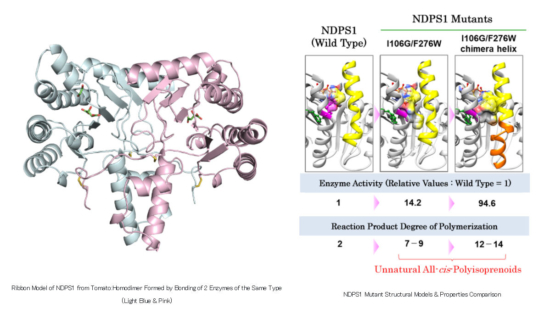SRI: Better tyre rubber through tomato research
 Source: SRI
Source: SRI
Tyres and tomatoes. At first glance these have little in common apart from the same initial letter, but Sumitomo Rubber Industries, Ltd. may beg to differ. The Japanese manufacturer shares news of joint research work focusing on an enzyme that is found in tomatoes and has a similar structure to those involved in the biosynthesis of natural rubber.
Research undertaken with Associate Professor Seiji Takahashi of Tohoku University, Associate Professor Satoshi Yamashita of Kanazawa University and Group Director Masaki Yamamoto, Kohei Takeshita and other researchers at the RIKEN SPring-8 Center has resulted in a greater understanding and successful functional modification of the cis-prenyltransferase (NDPS1) enzyme found within tomatoes. SRI shares that use of the SPring-8 Synchrotron Radiation Facility facilitated this research.
NDPS1 is an enzyme belonging to the cis-prenyltransferase family, which also includes the enzymes involved in the biosynthesis of natural rubber. SRI explains that it has thus been long presumed that the two were likely to possess similar structures. “As the properties of NDPS1 make it better suited to structural analysis than the natural rubber synthases found in Pará rubber trees, our joint research team set about studying the structure of NDPS1 using SPring-8,” states SRI.
“As a result of our research, we have not only shed light on the structure of NDPS1 and determined the key sections affecting the length of its synthesis products, but have also succeeded in increasing the degree of polymerisation and significantly enhancing the chemical reactivity of synthesis products by introducing new mutations to these key sections. With this breakthrough, it has now become possible to biosynthesise compounds that do not exist in nature.”
SRI expresses a hope that gaining a greater understanding of the structure of NDPS1 will make it possible to “shed further light on the mechanisms behind the biosynthesis of natural rubber, which in turn will allow for new advancements in the development of technologies to ensure a stable and reliable supply of natural rubber.”
Results of the joint undertaking have been published in the 8 February issue of FEBS Journal, a biweekly peer-reviewed scientific that covers research on all aspects of biochemistry, molecular biology, cell biology, and the molecular bases of disease.




Comments